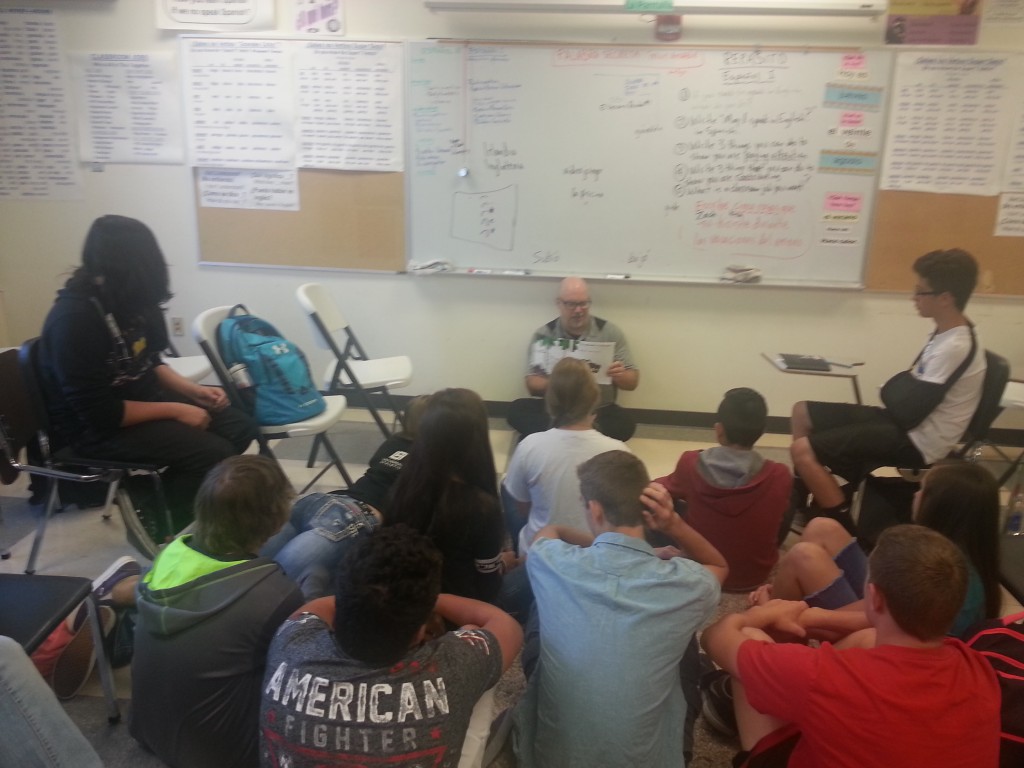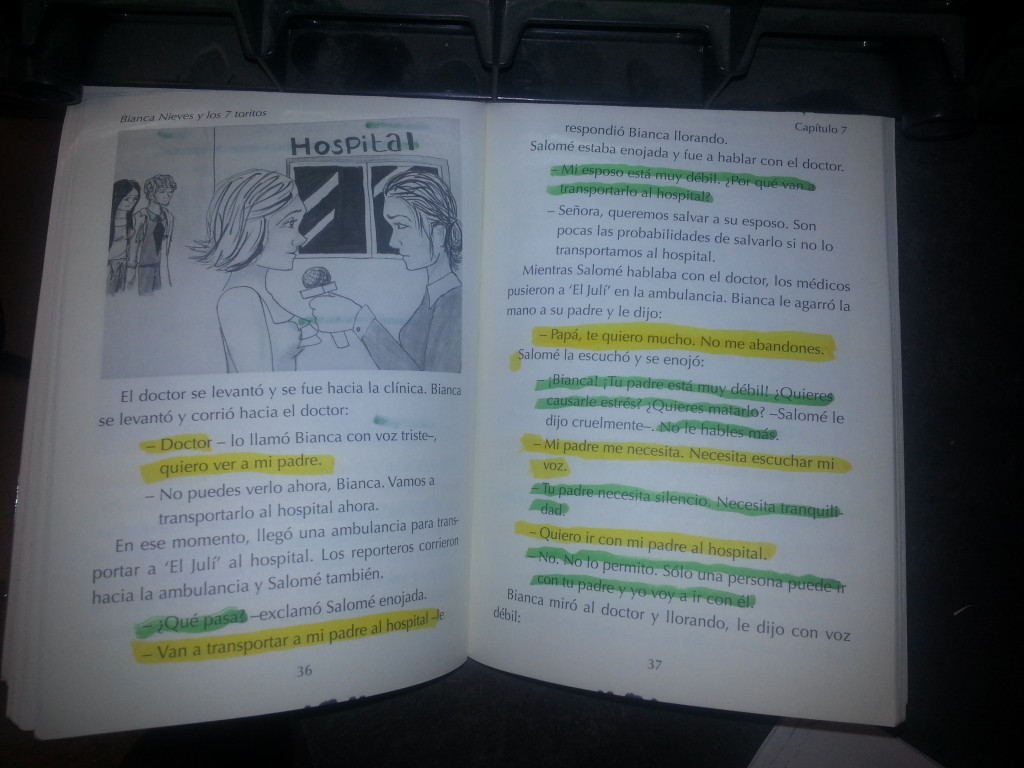
Kindergarten Reading with Big Book & Student Teacher
The highlight of the week in my Spanish language classes is usually Kindergarten Reading time. My students enjoy being read to and I enjoy reading to them. It generally happens towards the end of the period on Thursdays. Normally I read picture books to them (big books if I can find them) while they listen, sit on the floor and eat cookies.
Here is a list of picture books in Spanish that my students have enjoyed over the years. Some are big books. If you type the ISBN into a search engine, places where that book is sold will appear in the results.
This school year I began to read chapter books with my level three students. I read to them almost every day for a while. Just a chapter or so at a time. Usually for five minutes at the beginning of class. I wanted to establish a tone of enjoyment and expectation in a class that was low energy and needed some wooing.
As with Kindergarten reading, when I read novels to students I was the only one with a book. With Kindergarten reading the students that are sitting close enough can see the text, but most cannot. When reading a novel aloud, no one was able to see the text. They were only listening when I did it this year. Alina Filipescu lets students follow along with their own copy of the book as she reads aloud, which seems like a good idea because they will get more reinforcement.

Kindergarten Reading with a normal sized book. The boys like to sit in the front.
I was attempting to recreate the experience I had in elementary school when our sixth grade teacher, Mr. Pyle, would read to us after lunch. He read so many good books to us and we loved it: Tom Sawyer, Little Britches, Man of the Family, Rascal, Anne of Green Gables, Old Yeller and more. What a gift. Mr. Pyle, usually read just a little at a time to us, perhaps for 15 minutes. But sometimes he would read for an hour or more, and twice, he read for the entire afternoon! Listening to those novels unfold and imagining the stories in my head inflamed my love for reading. It contributed to my love of books. Thank you, Mr. Pyle. Good work.
I wanted to spread that kind of reading infection among my own students in Spanish class by reading aloud to them.
When I saw my student teacher attempt to do a read aloud with a novel, I realized that were some techniques I was using that made it work. Some of those techniques were unconscious, so we had to talk and reflect to discover exactly what she was doing differently so that she could recreate the experience for the students. Through trial and error we were able to define the best parts of what was working. And with practice she was able to master them.
Here are the two best techniques we came up with:
1) Read slowly
2) Use different voices
You should almost always read al oud slowly. There is no rush. This is shared pleasure reading, not a reading race. You are not trying to get the reading out of the way so you can move on to the next item in your lesson plan. You are serving up joy to your students. You are all savoring the experience.
oud slowly. There is no rush. This is shared pleasure reading, not a reading race. You are not trying to get the reading out of the way so you can move on to the next item in your lesson plan. You are serving up joy to your students. You are all savoring the experience.
For the voices, the trick is to pre-read the text. You do not want any unusual words to throw you as you read and you need to know which character is speaking. To create an appropriate voice you need to know something about their personalities and tendencies of each so that you can create a distinct voice for each major character in the story.
The narration has one voice, usually your own normal speaking voice. Giving each character a voice allows the listener to instantly identify who is speaking. As Carol Hill says, you need to let your “inner drama queen emerge.”
I used this different voices technique to the delight of my own daughters, nieces and nephews when they were small.
As the reader of the text you have the advantage of the punctuation on the page. You can glance ahead to see who is speaking, but the hearer is merely listening. If you read in a single monotone voice there are no cues other than the context. It is MUCH easier to follow a story with the extra coloring of distinctive character voices.
In a second language listeners need more help. They are barraged with a torrent of words, some of which are brand new. Like little children, they can more easily follow the story and imagine the conversations when each character is quickly identifiable because of the unique voice.
But how do you identify which character is speaking on the go? You want your read aloud to be smooth, so you cannot stop in mid sentence and start over with another voice. An inexperienced read aloud teacher may have trouble juggling the multiple tasks of looking ahead to see who is speaking and with what tone, coming up with a unique voice and reading in a second language (perhaps with words that are not familiar) all at once.
The method we came up with for my student teacher was to pre-read parts of the novel and highlight what each character is saying with different colors. Then we practiced reading aloud with different voices before the “performance” in the classroom.
In the book pictured above, Bianca Nieves y los Siete Toritos by Carrie Toth, it was easy to come up with distinct voices.
In this story the step mother was cruel and selfish, so I used a snide, short, biting tone when she spoke.
The father was loving, but a bit clueless, so I used a slow, tender dad voice.
Bianca, the main character, was intelligent and determined, so I used a strong girl voice for her.
As you narrate, remember the advice from Mem Fox for reading aloud in her fabulous book Reading Magic. Do not read in a monotone. Reading is inherently interesting and fun, so don’t ruin it with your lousy technique. Match your narration to the novel. Change your voice to match the text. Mem suggests using seven simple words: High/Low, Fast/Slow, Loud/Soft and Pause. Repeat those like a chant in your mind until they stick, then summon that memory as you read to match your voice with the events in the book you are reading.
If you haven’t read aloud like this before, practice this technique on your own children or with the neighbor kids this summer. Those extra repetitions will enrich your classes when you return to the classroom in the fall.
I will be presenting on “Establishing a Free Voluntary Reading Program” at the 2016 iFLT Conference at the Read House (how appropriate!) in Chatanooga, Tennessee on July 22. More information and discussion about this technique and others that have worked for me will be presented in that session. See you there!

Your advice/tips about read-aloud have inspired me to try it with my level 3 and 4– Some of my classes love dia de Kinder, others not so much, but this year most seem to love to read–what a joy!!! (I channeled some of your mojo this week when I introduced FVR, handed out your reading-strategies bookmarks, and went over a few of the strategies you were so kind to put on bookmarks. Thanks for all your “free stuff” and your inspiring website. — Amy O’C at Palmer